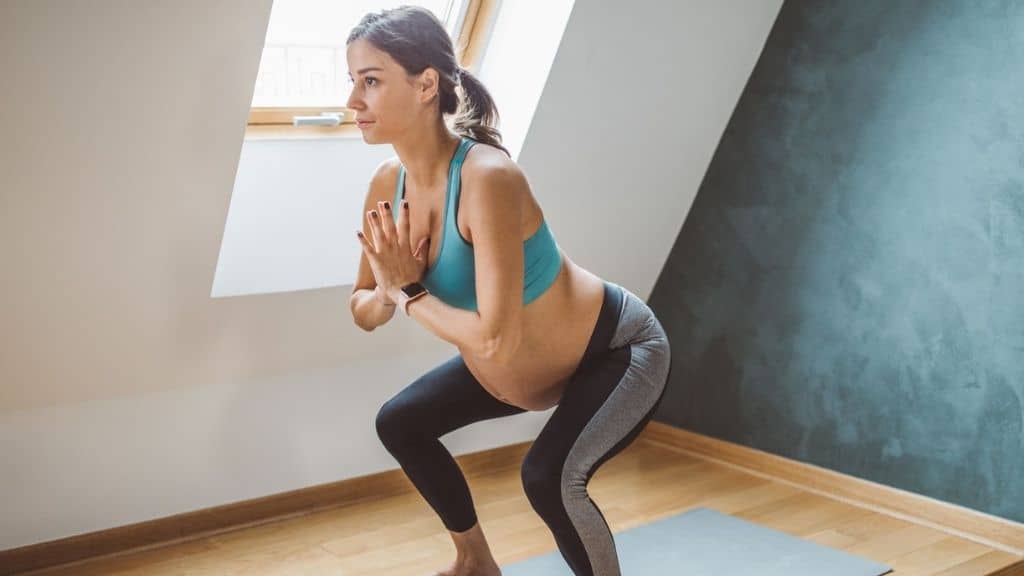
Table of Contents
Can you do squats while pregnant is this the question that every mom-to-be might have asked at least once? It is no wonder that exercising during pregnancy is good for your and your baby’s health as it can reduce your pregnancy symptoms like pain and aches, improve blood circulation, control the impending weight gain, and give you the proper amount of sleep.
Exercising is especially important to prepare the body for going through labor, delivering the baby, and the postpartum changes. The American College of Obstetricians and Gynaecologists (ACOG) proposes that pregnant people should get around 150 minutes of aerobic activity every week.
Are all kinds of workouts safe for pregnant people though? And is it safe for all the 9 months of pregnancy? Is it safe to do squats while pregnant as it involves the pelvis? These are some questions that this page answers. It is perfectly okay to be confused about which exercises to do while pregnant as your and your baby’s safety is of utmost priority. Crunches, squats, or planks, which is the appropriate one? Squats are the most beneficial exercise to do while pregnant.
Why Are Squats Considered Safe While Pregnant?
Squats are strength exercises that increase the size and strength of all the lower body muscles. Along with that, squats will also increase your core strength which is why it is highly recommended during pregnancy. It improves hip mobility and blood circulation to your entire body- the two most essential body requirements to prepare for labor.
The squatting position is also a birthing position as it relieves back pain during labor. The squat position allows gravity to help your baby make its way towards the final destination through the birth canal. There are several benefits to squatting during birth like
- Lesser injuries to the perineum
- Les vulvar edema
- Less blood loss
- Less epidural
- Wider pelvic
The physical therapist and spokesperson for the American Physical Therapy Association, Carrie Pagliano says,” Squats are functional movements. We have to squat to sit on a toilet or pick up items off the floor. They shouldn’t be fearful movements.”
Why Should You Not Do Squats While Pregnant?
Certain contraindication however exists for doing squats while pregnant. So it will be a good idea to discuss your workout routines with your OBGYN to avoid all or any concerns.
- Placenta previa
- Cervical insufficiency
- Short cervix
- Previous knee, back, or hip injuries
- Certain risks in pregnancy
Safest Trimester For Doing Squats While Pregnant
All trimesters are safe for doing squats as these exercises will help the pelvic muscles to relax and pave the way for easy delivery. However, some people find it difficult to squat during the end of the third trimester as their center of gravity would have shifted. This shift would have caused additional stress on the spinal joints. So it will be a good idea to have someone to assist you while doing these workouts.
Trimester precautions
To maintain your balance during the later trimesters, you can do squats by maintaining a wider stance by using a chair or a table for support. Many exercises done during pregnancy will require new mums-to-be to widen their stances to accommodate the changes in the pelvic region and the room for the growing belly with the baby. Remember to be careful of deep twists and modify your exercises accordingly. You can also scale your squats down to a half or a quarter squat if you find it difficult to get up from a squat.
Another precaution you have to keep in mind is the increase in your heart rate while exercising. If you overdo it the increased heart rate would not be safe for you or your baby.
Mind Your Techniques
Your exercising techniques need to be precise when you are exercising in your pregnancy. These are some points to remember but if you are still not sure of your positions do talk to a fitness expert.
- Keep the spine in a neutral position
- Keep your chest up
- Keep your feet flat on the ground
- Keep your knees pointed in the same direction as your toes
Relax And Unwind
You should take your workouts easily and not stress yourself out. Each movement is to be taken in a controlled and measured way. A hormone called relaxin is released during pregnancy that loosens your ligaments and joints which is why it is crucial that you do not overstretch and injure yourself.
Bodyweight squats, supported squats, sumo squats, chair squats, and deep squats are some of the squatting exercises that are recommended. You might want to wait till you give birth to do weighted squats.
Hydrate!!!
At times we tend to forget the most obvious health routine: water. Do not at any cost overheat or dehydrate yourself during your pregnancy. So keep a bottle of water ready at all times and take a sip before, during, or after doing your pregnancy exercises. Watch out for these signs of dehydration,
- Dizziness
- Passing dark yellow urine
- Racing or pounding heart
- Passing less amount of urine
Listen and Understand Your Body
You should be comfortable with the depth of your squat to not lose balance and fall over. During the latter part of your pregnancy, your pelvic regions have almost made themselves change to endure childbirth which is why you should especially be careful then. You know your body best so take a rest if you feel like it without any hesitation.
It is advised that pregnant people develop a love language between themselves and their bodies and keep an eye out for any abrupt changes. If you feel short of breath or dizzy with nausea you should immediately stop exerting yourself and approach a health care provider. Apart from these, vaginal bleeding, contractions, or pain are some other emergency situations.
Pregnancy Safe Exercises
Squats are indeed safe but in case you don’t feel like it, here are some other exercises that you could try. These are even easier to do during your trimester.
- Walking
- Water fitness
- Spinning
- Yoga
- Interval training
Water fitness, walking, and spinning are some great cardio alternatives for mums-to-be. Interval training or circuit-style training are other exercises that challenge muscular and cardiovascular endurance. Yoga, on the other hand, is ideal for maintaining stability, strength as well as endurance.
Squats While Pregnant Final Conclusion
Squats are a great form of exercise when you are pregnant unless and until your health care provider advises otherwise. Not only are they safe but also are beneficial in innumerous ways like getting you ready for birth by improving blood circulation and enhancing muscle endurance. You only have to remember to not overdo it and keep an ear out to listen to your body. If any movement feels tipsy immediately quit and rest yourself. Alarming disruptions in your body means you need to get in touch with your doctor asap.









